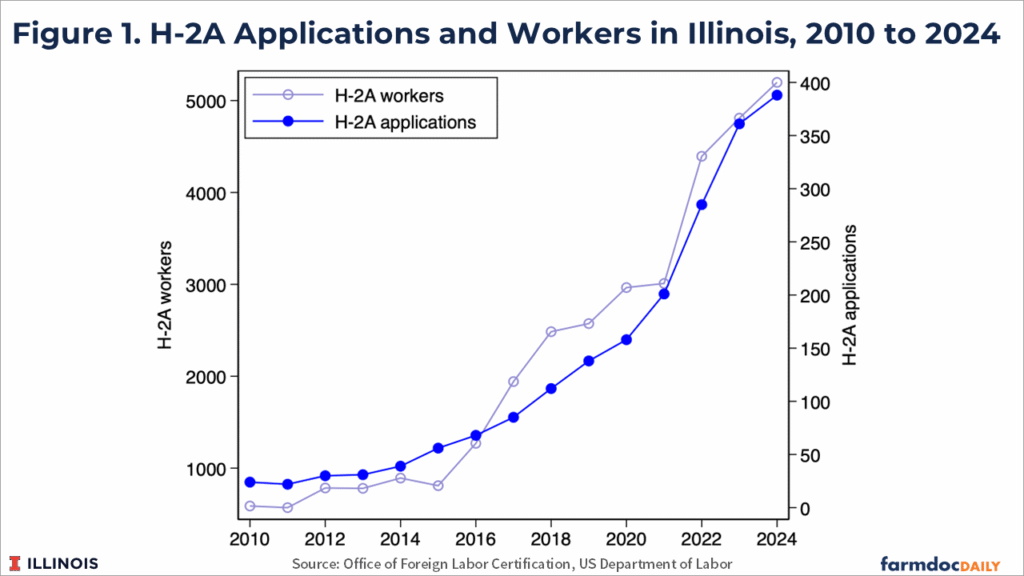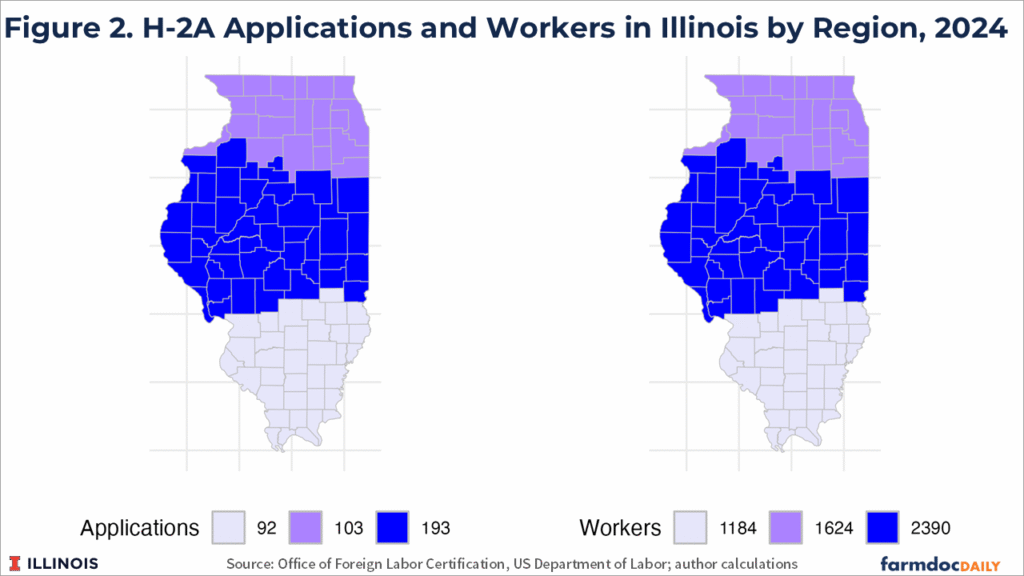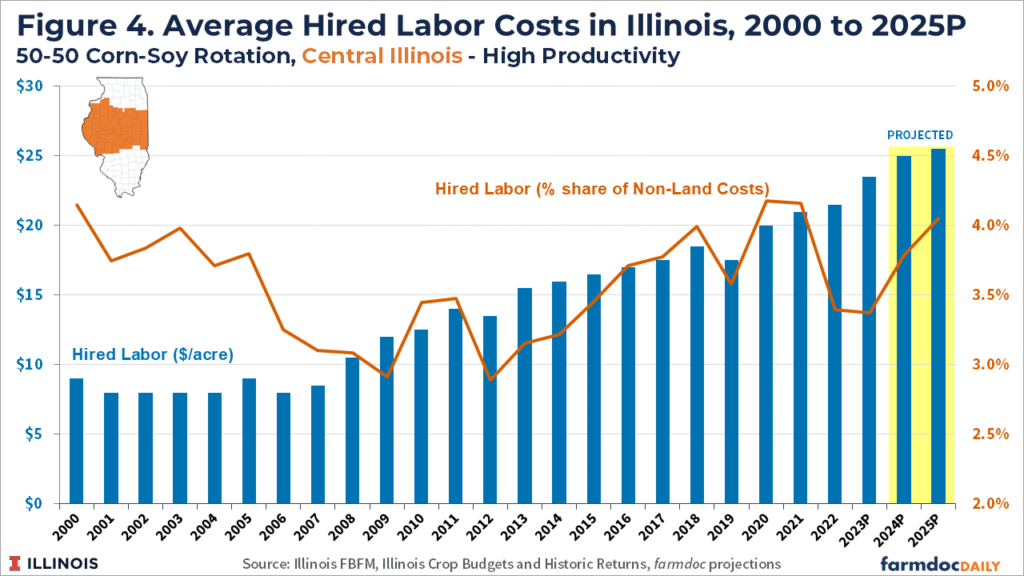The role of H-2A Workers in Illinois
The H-2A program addresses seasonal labor shortages in U.S. agriculture by certifying employers to hire foreign workers for temporary agricultural jobs when specific requirements are met. While use measures (applications and authorized workers) are higher in states associated with more labor-intensive crop and livestock operations, the program is used nationwide including Illinois (see farmdoc daily from July 9, 2025). In fact, percentage growth in certified H2-A workers in Illinois has far outpaced that at the national level since 2010.
In 2022, Illinois employed approximately 53,000 hired farm workers (USDA Agricultural Census, 2022). That year, about 4,400 workers were employed under the H-2A program, representing 8.3% of all hired farm workers in the state. By 2024, the program certified 5,198 workers in Illinois—a nearly 9-fold increase from the 588 workers certified in 2010 (Figure 1, left axis). While Illinois is not among the states with the highest use of the H-2A program, it ranks 18th in certified workers and 23rd in applications nationwide. Notably, the growth in H-2A workers in Illinois outpaces the 300% increase observed at the national level since 2010 (see farmdoc daily from July 9, 2025). This rise in worker numbers coincided with an increase in applications, which grew more than ten-fold from 24 in 2010 to 388 in 2024 (Figure 1, right axis).
H-2A Workers by Region in Illinois
Among Illinois’s three regions used for Illinois crop budgets, Central Illinois led in H-2A applications with 193 in 2024, followed by Northern Illinois (103) and Southern Illinois (92). In terms of certified workers, Central Illinois again led with 2,390, followed by Northern Illinois (1,624) and Southern Illinois (1,184) (Figure 2). In 2024, McHenry and Whiteside counties in northern Illinois, and Sangamon and Mason counties in central Illinois recorded the highest numbers of applications. Whiteside and McHenry (northern), and Champaign and Mason (central), counties had the most certified workers.
Illinois Farm Types Supported by H-2A Workers
Unlike national H-2A requests, which are concentrated in labor-intensive crops in states like California, Florida, Georgia, and Washington, Illinois sees a higher proportion of requests for field crops and grains. Grains and oilseeds, mainly corn and soybeans, account for 82% of the total market value of agricultural products sold in Illinois (USDA Agricultural Census, 2022). Although these crops are not as labor-intensive as other farm types, they are the primary reason for H-2A worker requests in the state—second only to requests for general farm operations which could apply to various farm types. Applications for workers in more labor-intensive fruit and vegetable production and livestock operations follow.
Hired Labor in Illinois
Figure 4 illustrates the increase in hired labor costs experienced by farms in central Illinois. Since 2000, per acre labor costs have tripled and have been a primary driver of the increases in overhead costs on Illinois farms (see farmdoc daily from December 19, 2023). As a share of total non-land production costs, hired labor declined during the 2000s but has since been trending back upward, mirroring trends in national labor costs (see farmdoc daily from July 9, 2025). Similar levels and trends in hired labor costs also exist in the northern and southern Illinois regions.
As most H-2A requests in Illinois are for general farm operations and field crop production, it is important to facilitate access to workers with machinery operation skills. The size and complexity of modern farm equipment necessitates skilled labor, which can be more challenging to identify from both domestic and migrant labor pools. The seasonality of production of the major field crops, particularly in a state like Illinois, introduces additional challenges for farms to meet their labor needs.
Conclusions
The growth in use of the H-2A temporary agricultural work program over the past 15 years, both at the national level and within Illinois, is an indication of the labor market challenges facing nearly all business types in the U.S. Labor market trends – including relatively flat labor productivity, declining labor force participation, increasing costs, and baby boomer retirement – suggest these labor market challenges will continue to persist (see farmdoc daily articles from January 6, 2022, January 11, 2023, and June 26, 2024). Farms and other agricultural businesses seem poised to continue to rely on a variety of labor sources, including H-2A workers, for the foreseeable future.
Figure Notes: The number of workers reported in Figure 1 is the total number of authorized workers in the H-2A program in each fiscal year while the number of applications is the total number of applications submitted regardless of their approval status in each fiscal year. Figure 3 classifies primary crops into up to 11 categories. Farm operations include drivers, general farm workers, agricultural equipment operators, cooks and others. The miscellaneous category includes silage, peanuts, pecans, nuts, almonds, clovers and others.
References
Paulson, N., C. Zulauf, G. Schnitkey and J. Colussi. "Rising Overhead Costs Driven by Labor and Interest." farmdoc daily (13):230, Department of Agricultural and Consumer Economics, University of Illinois at Urbana-Champaign, December 19, 2023.
USDA National Agricultural Statistics Service, 2022 Census of Agriculture. Complete data available at www.nass.usda.gov/AgCensus.
Valencia, C. and N. Paulson. "The Growing Role of H-2A Workers in U.S. Agriculture." farmdoc daily (15):125, Department of Agricultural and Consumer Economics, University of Illinois at Urbana-Champaign, July 9, 2025.
Zulauf, C. and G. Schnitkey. “US Price Inflation – Focus on Labor’s Role.” farmdoc daily (13):5, Department of Agricultural and Consumer Economics, University of Illinois at Urbana-Champaign, January 11, 2023.
Zulauf, C., G. Schnitkey, N. Paulson and K. Swanson. “US Labor Market and Labor Wage Inflation.” farmdoc daily (12):1, Department of Agricultural and Consumer Economics, University of Illinois at Urbana-Champaign, January 6, 2022.
Zulauf, C. "US Inflation and Labor." farmdoc daily (14):119, Department of Agricultural and Consumer Economics, University of Illinois at Urbana-Champaign, June 26, 2024.
Disclaimer: We request all readers, electronic media and others follow our citation guidelines when re-posting articles from farmdoc daily. Guidelines are available here. The farmdoc daily website falls under University of Illinois copyright and intellectual property rights. For a detailed statement, please see the University of Illinois Copyright Information and Policies here.











